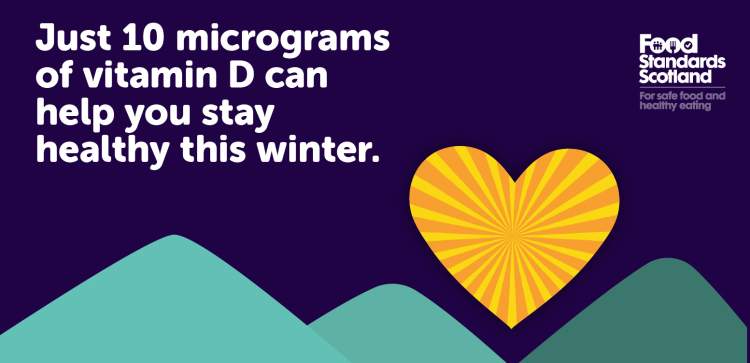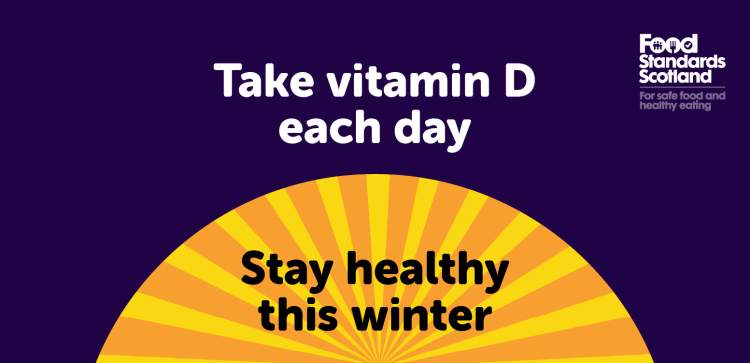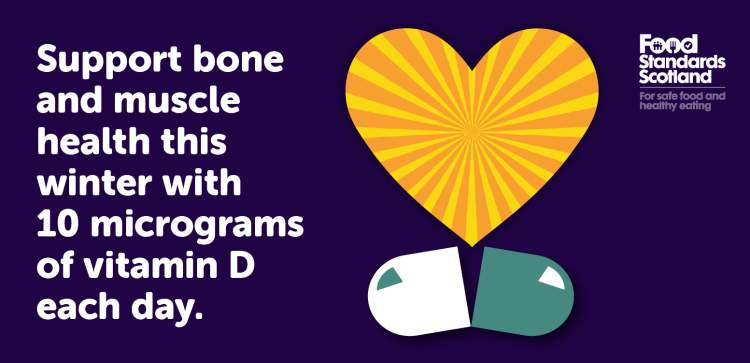News & Updates
Your questions on vitamin D answered by Food Standards Scotland’s expert

 Our Senior Public Health Nutrition Advisor, Alana McDonald, answers some frequently asked questions about vitamin D.
Our Senior Public Health Nutrition Advisor, Alana McDonald, answers some frequently asked questions about vitamin D.
Most people should be able to get all the nutrients they need from a healthy, balanced diet.
Vitamin D is an exception because it is only found in small amounts in some foods.
Sunlight is our main source of vitamin D. In Scotland, we only get enough of the right kind of sunlight for our bodies to make vitamin D between April and September. This means that for roughly half the year, between October and March, it is not possible for our bodies to make vitamin D from sunlight.
So what is the advice?
Since it is so difficult to get enough vitamin D from food, we encourage everyone to take a daily supplement containing 10 micrograms of vitamin D, particularly between October and March.
To help, we’ve answered some frequently asked questions on vitamin D and debunked some of the common myths.
Why should I take a daily supplement?
Vitamin D is really important for keeping our bones and muscles healthy. Not getting enough vitamin D can lead to bone deformities such as rickets in children, and bone pain caused by a condition called osteomalacia in adults.
How much should I take?
A daily 10 microgram supplement is recommended for most adults and children over 1 years old. Although higher dosages of vitamin D are available to buy from shops and pharmacies, this is not required for most people unless advised specially by a clinician.
Can I take too much vitamin D?
It is possible to have too much vitamin D from supplements. Unless your clinician has advised you differently, 10 micrograms a day will be enough. Having too much vitamin D from supplements could be harmful.
- Adults and children over 11 should avoid daily high dose vitamin D supplements containing more than 100 micrograms, and
- children aged 1-10 should avoid supplements with more than 50 micrograms. Infants under 12 months should have no more than 25 micrograms a day.
Some people have certain medical conditions which mean they may not be able to safely take as much. You should seek advice from your clinician if you have any doubts.
There’s no risk of your body making too much vitamin D from sun exposure as the body self regulates vitamin D made in this way. But always remember to cover up or protect your skin if you're out in the sun for longer periods to reduce the risk of skin damage and skin cancer. Once sunscreen is correctly applied, vitamin D synthesis is blocked. 10–15 minutes of unprotected Scottish sun exposure is safe for all, but care should always be taken to cover up or apply sunscreen before any exposed skin becomes red or begins to burn. Staying in the sun for prolonged periods without the protection of sunscreen increases the risk of skin cancer.
How much do children under 1 year old need?
The advice for infants is different depending on whether you breastfeed or formula feed your baby.
- Breastfed babies from birth to 1 year of age should be given a daily supplement containing 8.5 to 10 micrograms of vitamin D to make sure they get enough.
- Formula-fed babies shouldn't be given a vitamin D supplement until they're having less than 500ml (about a pint) of infant formula a day, as it is already fortified with vitamin D.
Read advice and support for parents to follow the recommendation for infants from birth to 6 months.

Are there any groups of people who are at higher risk of vitamin D deficiency?
There are some groups of people who are at higher risk of vitamin D deficiency and are advised to take a daily supplement all year round. This includes:
- All pregnant and breastfeeding women
- Infants and children under 5 years old
- People who have low or no exposure to the sun, for example those who cover their skin for cultural reasons, are housebound, confined indoors for long periods or live in an institution
- People from minority ethnic groups with dark skin such as those of African, African-Caribbean and South Asian origin, who require more sun exposure to make as much vitamin D
Where can I buy a vitamin D supplement and how much does it cost?
You can buy vitamin D supplements from some supermarkets and most pharmacies, and you may also be able to order online from reputable retailers. Prices may vary but you should be able to buy a three-month supply (90 tablets) for a few pounds. They don’t need to be branded supermarket and pharmacy own label products are also good options.
Healthy Start vitamins, which contain Vitamin D, are available free to all pregnant women in Scotland. Ask your midwife or health visitor for further information. Breast feeding women and children under 3 years in Scotland can get free supplements containing the recommended amounts of vitamin D.
Please contact your health visitor for more information.
What are international units and how are they different to micrograms?
Sometimes supplements state the amount of vitamin D in International Units (IU). 1 microgram of vitamin D is equal to 40 IU. So, 10 micrograms of vitamin D is equal to 400 IU.
What is the difference between vitamin D2 and vitamin D3?
The two major forms of vitamin D are D2 and D3. Vitamin D2 is formed by the action of sunlight on fungi and yeast. Vitamin D3 is largely sourced from the action of sunlight on the skin of animals and is the only form of vitamin D which can be produced by the skin.
Supplements may include either form of vitamin D. Both help to increase levels of vitamin D in the blood.
Why do some supplement labels say that the recommendation for vitamin D is only 5 micrograms per day?
Prior to leaving the EU, food labelling regulations were harmonised at EU level. Now that the UK has left the EU these regulations have become retained EU law and forms part of our domestic food law in Great Britain. As a result products on the market in GB are required to be labelled in accordance with the requirements set out in the retained EU regulation. The retained EU Nutrient Reference Value (NRV) for Vitamin D is 5 micrograms (mcg) per day compared with the UK recommendation of 10 micrograms per day
Why can’t we make vitamin D from sunlight over winter?
In Scotland, our northern latitude means that between the months of October and March sunlight does not reach us at the right wavelengths in order for our skin to make vitamin D.
How many people in Scotland take Vitamin D supplements?
In 2021, less than half of adults and children in Scotland reported taking vitamin D supplements (36% of adults and 41% of children).
Can I get all my vitamin D from food?
Vitamin D is only found in small amounts in some foods and it is difficult to get enough through diet alone. To meet the 10 microgram recommendation for vitamin D, you would have to eat the equivalent of either:
- six eggs
- four tins of sardines
- around four bowls of cornflakes
- 10 UV treated mushrooms each day.

Should I buy a multivitamin or vitamin D plus other nutrients like calcium?
Most people should be able to get all the nutrients they need from a healthy, balanced diet. There are some exceptions, including for pregnant women or if you have been advised to take supplements by your clinician.
If you are unsure, ask your clinician, pharmacist, midwife or health visitor for further information.
Is the advice new?
No. The advice to consider taking vitamin D supplements is based on recommendations from the Scientific Advisory Committee on Nutrition (SACN) who provide independent advice to government based on scientific evidence.
Find out more about vitamin D
- Information from Food Standards Scotland
- General advice leaflet setting out the current advice on vitamin D, available in English, Arabic, Polish, Traditional Chinese and Urdu: Vitamin D and You
- Advice and support for parents